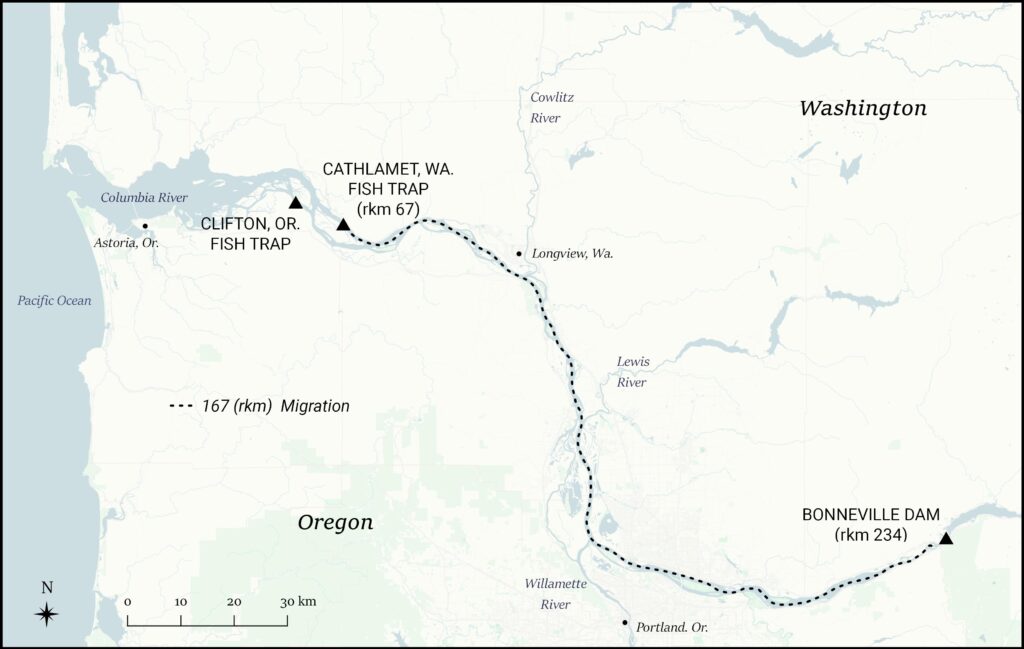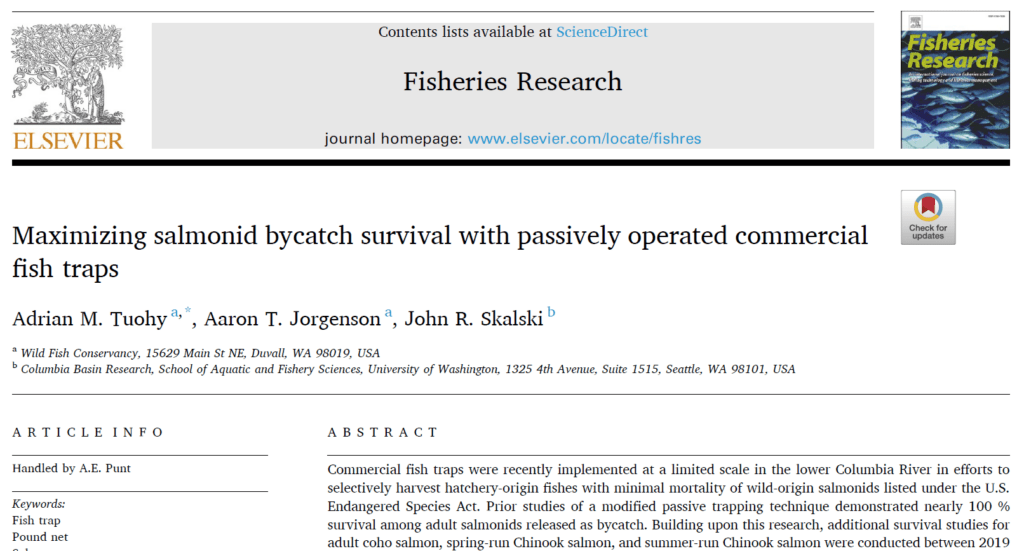Wild Fish Conservancy (WFC) is thrilled to announce our most recent peer-reviewed scientific journal publication for the Columbia River fish trap project—hot off the press from the journal of Fisheries Research!

The publication presents three definitive studies evaluating bycatch survival at two fish trap sites in the lower Columbia River between 2019 and 2021. Findings for adult spring-run Chinook Salmon, summer-run Chinook Salmon, and Coho Salmon validate the conclusions of prior studies for passively operated fish traps, with release survival estimated at or near 100%. Results of the publication provide the most irrefutable evidence to date that contemporary fish traps can allow for selective harvesting and release of wild salmonid bycatch unharmed in the lower Columbia River.
Last spring, we shared the preliminary findings for our spring-run / summer-run Chinook Salmon survival study. Since securing genetic results from the lab after years of waiting, we were finally able to complete the 2019 analysis of Chinook Salmon survival from a passively operated fish trap in the Cathlamet Channel, lower Columbia River, WA.
In this study of bycatch survival, WFC biologists tagged, genetic sampled, and released spring-run and summer-run Chinook Salmon passively captured with the fish trap in 2019 and evaluated upriver detections at Bonneville Dam over a 167 km, ~7 day migration. Although fieldwork for the project was completed nearly three years ago, genetic results assigning each tagged fish to populations above or below Bonneville Dam were absolutely essential for completion of the post-release survival analysis to the tag detector at Bonneville Dam. This was due to the fact that some spring-run and summer-run Chinook Salmon encountered in the lower Columbia River originate from lower river populations and are destined to spawn in tributaries below Bonneville Dam. Therefore, any unbiased analysis of post-release survival to the Bonneville tag detector must account for the genetics of each fish to ensure that survival is only analyzed for the fish destined to head above Bonneville Dam.

Securing the genetic results from the lab in the spring of 2022, we were finally able to pair the genetic data to 110 tagged spring-run and summer-run Chinook Salmon captured using passive operations with the fish trap. Based upon our tagged sample of fish that had genetically assigned to populations originating upriver of Bonneville Dam (n = 88), we discovered that 100% of these passively captured fish survived the 167 km, ~7 day migration to Bonneville Dam.
These findings were nothing short of remarkable as no control group was available to account for well-established factors known to bias survival rates low in the absence of a control group (e.g., tag loss, upriver mammal predation, research handling/tagging effects, etc.). In other words, 100% survival from this study meant that the fish trap not only had a 0% mortality effect to Chinook Salmon at capture and release over 7 days, but not one tagged fish from the sample died from upriver marine mammal predation, not one tag fell off during the 167 km migration, nor did our research team damage a single fish during the rather stressful tag insertion and genetic sampling procedure.
Results of this major study remained preliminary until completion of the peer-review process and publication of the article in the journal of Fisheries Research last week! The publication was co-authored by WFC’s own Adrian Tuohy and Aaron Jorgenson, alongside veteran biometrician Dr. John Skalski of the University of Washington, Columbia Basin Research Lab.
Ensuring peer-review and summary of outlying data from WFC’s fish trap studies conducted on the lower Columbia River, the Fisheries Research publication by Tuohy et al. (2022) further incorporates 2020-2021 survival findings for Coho Salmon released from passively operated fish traps in both Washington and Oregon. Using a separate methodology that directly observed Coho Salmon survival from fish traps over 4 day and 6 day post-release periods in floating net pens (methods used by WDFW and ODFW for studies of tangle nets), we estimated post-release survival at 100% in 2020 and 96.5% in 2021. Similar to the study of Chinook Salmon survival, these studies also lacked control groups to account for physiological stress from the research process; therefore, the results were inherently conservative with survival biased low.

Together, the three studies recently published in the journal of Fisheries Research support the conclusions of prior studies and provide the most persuasive evidence to date that passively operated fish traps may allow for selective harvesting of targeted fish stocks with little to no mortality of adult salmonid bycatch in the lower Columbia River. For more information, we encourage our readers to view or download the full-length article for free at the following open-access link: https://doi.org/10.1016/j.fishres.2022.106495

This project was made possible by funding received under award NA17NMF4720255 and NA19NMF4720230 from the National Oceanic and Atmospheric Administration (NOAA) Fisheries Service, in cooperation with the Bycatch Reduction Engineering Program. Funding was also provided under award NA19NMF4270028 from NOAA Fisheries Service Saltonstall-Kennedy Grant Program. Additional support was provided from the Washington Department of Fish and Wildlife, Oregon Department of Fish and Wildlife, Patagonia, Inc., the Raynier Institute & Foundation, and the Burning Foundation.
Join our mailing list to recieve important updates on our work, the latest wild fish news, & opportunities to take action to support wild fish.
This site is protected by reCAPTCHA and the Google Privacy Policy and Terms of Service apply.
Wild Fish Conservancy is recognized as a 501(c)3 non-profit by the IRS